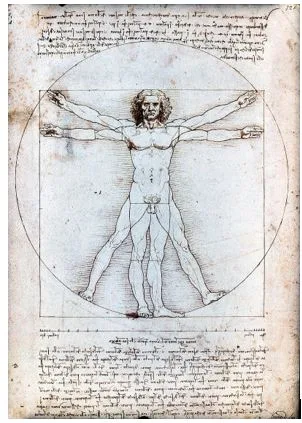The Mathematics of the Human Body: Where Numbers, Nature and Art Converge
It has long been known that mathematics is present everywhere around us. Almost everything in nature can be described through mathematical formulas—including the human body itself. From the tiniest cells to the way we move and breathe, mathematics shapes who we are. In many ways, we truly live in a world of mathematics.
Although people differ in height, weight, and body shape, the body itself is geometrically determined. The most famous depiction of human proportions comes from Leonardo da Vinci’s Vitruvian Man, a drawing that inscribes the human body within a circle and a square. Inspired by the Roman architect Vitruvius, Da Vinci used this illustration to show how human proportions could serve as a model for art, science, and architecture. Some of the proportions described include: the width of the hand equals four fingers, a person’s height is four cubits (or 24 palms), the length of outstretched arms equals one’s height, the distance from the top of the head to the bottom of the chin equals one-eighth of the total height, the maximum shoulder width is one-quarter of the height, and the length of the foot equals one-sixth of the height. Try measuring yourself—you may be surprised how accurate these ratios are.
Many of these proportions are connected to the golden ratio, a mathematical constant approximately equal to 1.618. Two quantities are said to be in the golden ratio when their proportions mirror the ratio of their sum to the larger of the two. Frequently found in art, architecture, and nature, the golden ratio has often been considered the epitome of perfection—and it is also embedded in the human form.
The human body is also built on symmetry. A vertical axis divides the body into two mirrored halves, though perfect symmetry never truly exists—adding to our uniqueness. The functioning of our organs, governed by the brain’s autonomous system, can also be mathematically modeled. For example, heart conditions such as arrhythmia or ischemia can be detected by recording the heart’s electrical activity through an electrocardiogram.
Mathematics also explains our body’s balance, or homeostasis. Our body temperature remains constant regardless of external conditions. Blood sugar levels stabilize even after consuming sweets. Without these finely tuned regulatory systems, survival would be impossible. Using graph theory and other mathematical tools, scientists can predict and explain disruptions in homeostasis—such as high blood glucose or low calcium in bones—and act before major health issues arise.
Each of the 7.9 billion people on Earth is unique and this uniqueness lies in our genetic code. Human DNA, stored in 46 chromosomes (half inherited from each parent), determines our appearance, talents, and personality. DNA is structured as two antiparallel spirals made of nucleotides—adenine (A), cytosine (C), guanine (G), and thymine (T)—arranged in unique sequences that form an individual code. This mathematical uniqueness allows forensic scientists to identify suspects, establish paternity, and even conduct historical research.
Before the adoption of the modern metric system (SI units), people often measured objects using body parts. Roman units included the digitus (finger), uncial (inch), palmus (hand span), pes (foot), cubitum (elbow length), passus (two steps), and mille passus (a mile). Remarkably, some of these measures—like inches, feet, and miles—are still in use today in the United States, Liberia, and Myanmar, even though the SI system is now the global standard.
Here are some fascinating facts about the human body:
- The adult skeleton consists of 206 bones, compared to about 300 bones in a newborn.
- The body contains over 200 types of cells, including stem cells with regenerative potential.
- We have more than 600 muscles, divided into skeletal, cardiac, and smooth muscle tissue.
- The human body contains 4 to 6 liters of blood and about 18 liters of water.
- The heart weighs around 300 grams, beats 60–100 times per minute, and accelerates with exertion.
- The brain weighs 1,000–1,300 grams and consumes about 25% of our total energy intake.
These numbers, of course, reflect averages for healthy adults and can vary from person to person.
To explore more about the fascinating intersection of mathematics, science and education visit eMatematika.hr , Croatia’s first specialized platform for online mathematics instruction. The platform is widely recognized for its top-quality mathematics tutoring services (instrukcije iz matematike visoke kvalitete) and Matura exam preparation (pripreme za maturu) for students of all levels.




